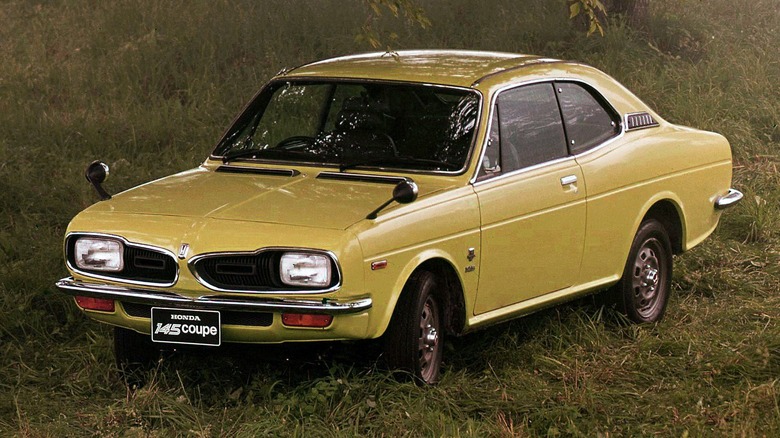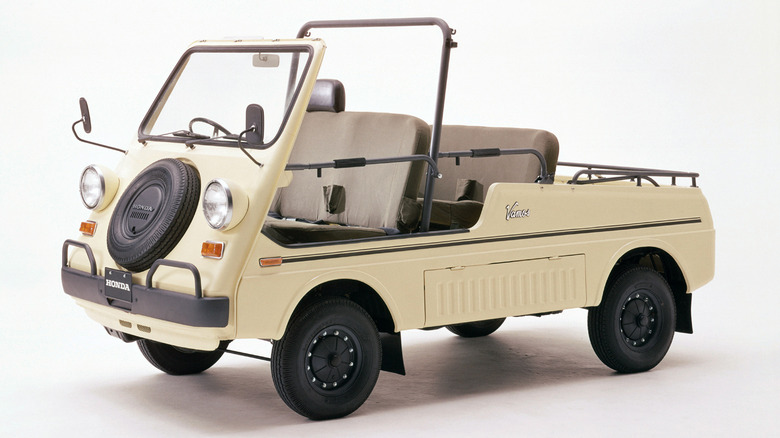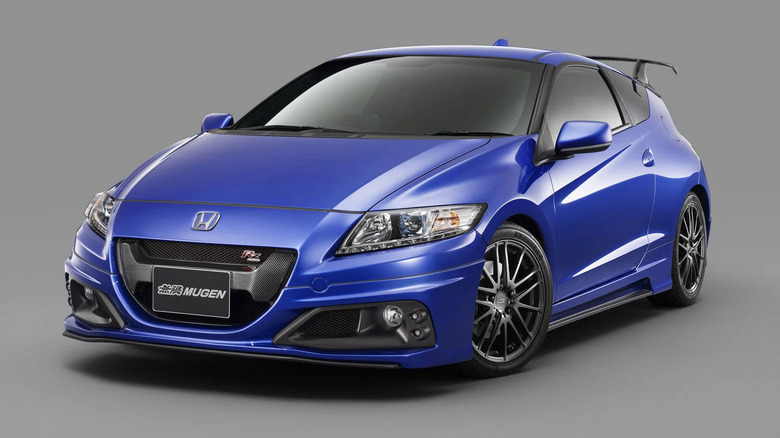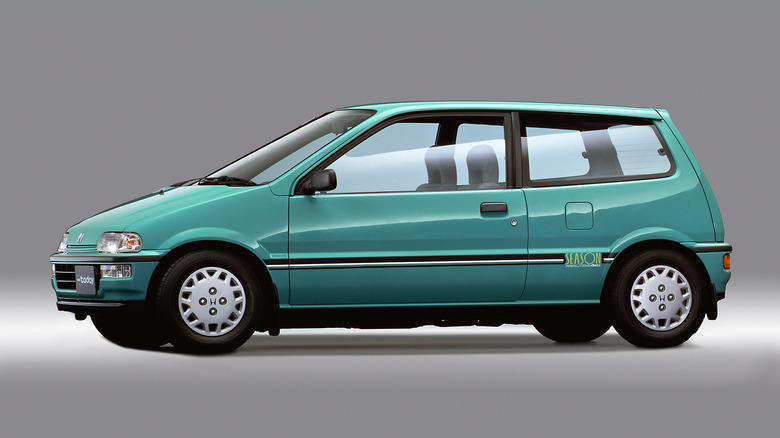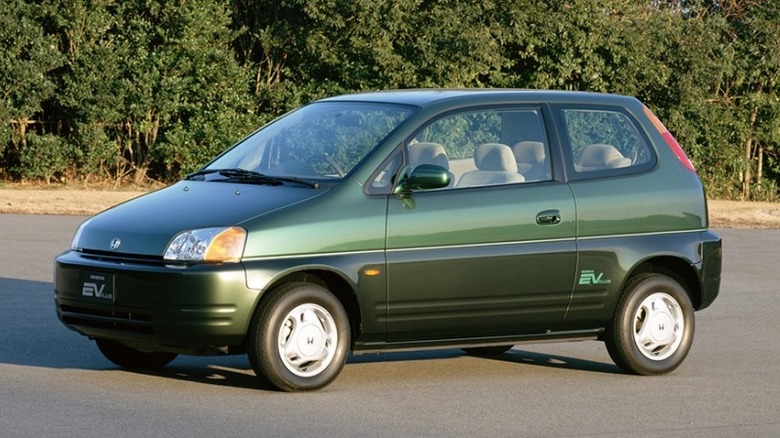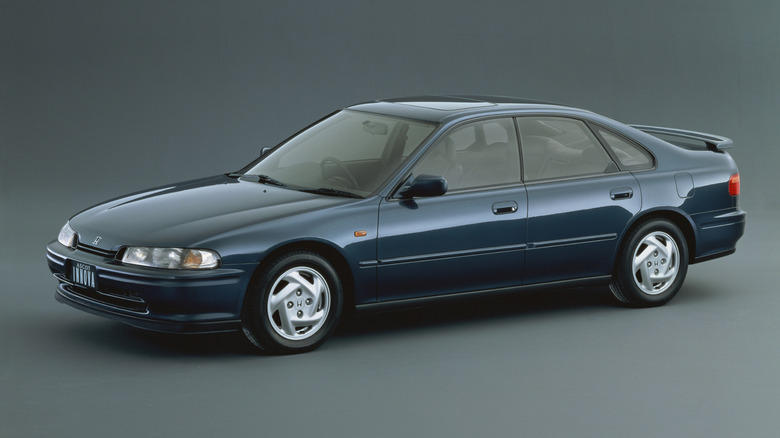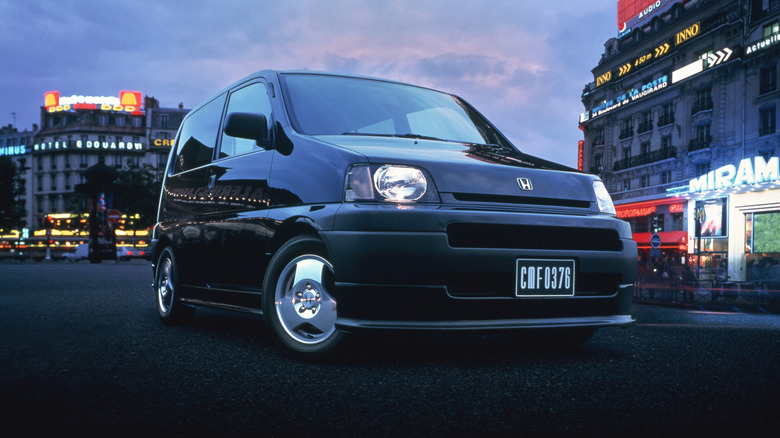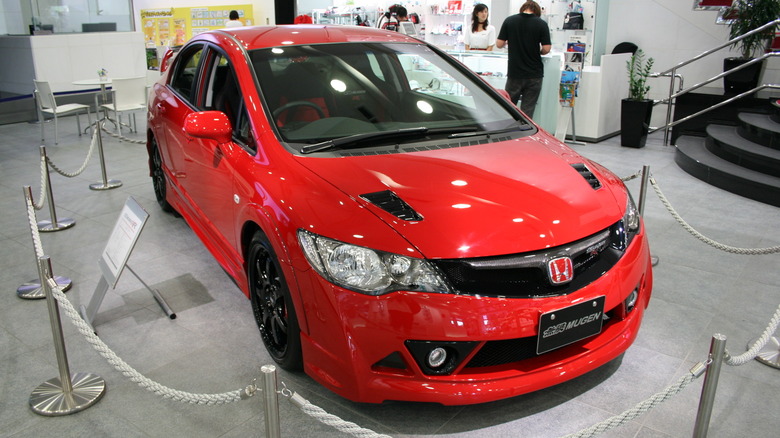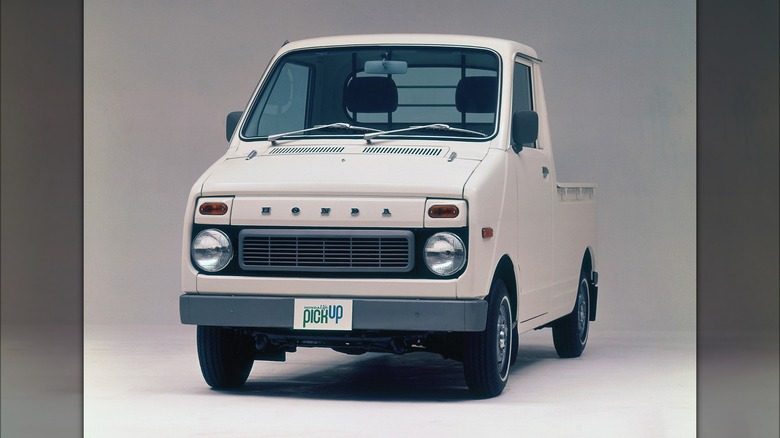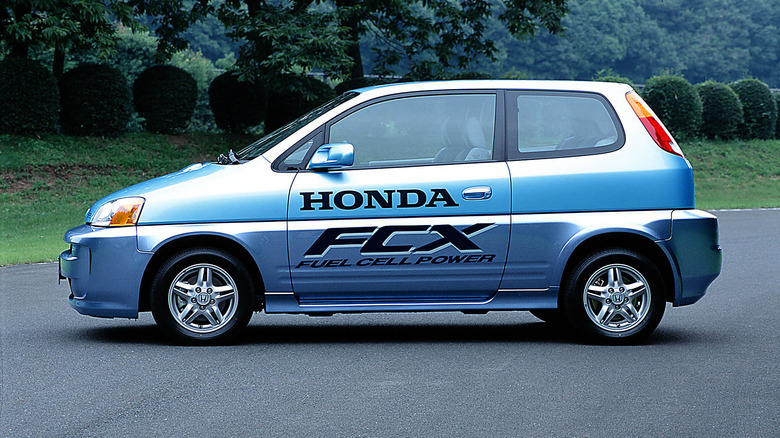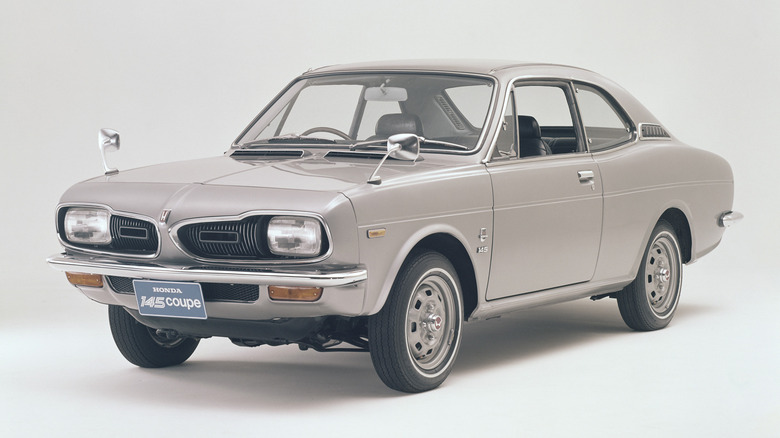10 Honda Models You Didn't Realize Existed
There are many famous nameplates in Honda history, from its segment-defining NSX to the bestselling Accord sedan and cult classic Beat kei car. Arguably none are more famous than the Civic, which has remained in production for more than half a century and can be found on roads all over the globe. However, for every well-known Honda model, there are others that have managed to slip under most enthusiasts' radars.
The brand's most obscure models include an all-terrain kei car, an early EV, and a rare track-focused version of the Civic that was limited to just 300 units. These long lost rarities were often never sold outside of Japan, but even Honda enthusiasts in the automaker's home country might well have forgotten about some of them. SlashGear dug through Honda's sprawling press archive to uncover these overlooked highlights from decades past, all of which many Honda enthusiasts may never have known existed.
Honda Vamos
Honda originally envisioned its Vamos kei car being used for everything from hauling construction materials to security patrols, but it didn't turn out that way. Unveiled in 1970, the Vamos was an adaptation of the brand's N360, with open sides and a removable fabric roof. It was available in a choice of three layouts, prioritizing either cargo or passengers, and featured a tiny 354cc engine making just 30 horsepower.
At launch, Honda thought it could sell 2,000 examples per month, but that figure proved to be wildly optimistic. When the Vamos was axed after three years, it had only sold a few thousand units across its entire production run. The trouble was, it simply wasn't very useful for doing the things Honda intended it for — other kei car competitors offered four-wheel-drive and larger engines, plus the benefit of a solid roof over the driver's head.
Thanks to its low sales figures and advancing age, examples are rare to come across today, but those that survive have become collectibles. They make a quirky alternative to beach cars like the Mini Moke and Fiat 500 Jolly, although they're even slower than both.
Honda CR-Z Mugen RZ
Mugen and Honda have an unusual relationship. The two companies are technically separate, but Mugen's founder is Hirotoshi Honda, son of Honda founder Soichiro and the current largest shareholder in Honda Motor Company. Mugen has been modifying Honda cars and motorcycles since the '70s, and has released a small number of standalone models, one of which is the Honda CR-Z Mugen RZ. Unveiled in 2012, the CR-Z Mugen RZ was an overhauled version of Honda's hybrid sports car and was sold only in Japan. It was limited to 300 units and retailed for 4,494,000 yen, around $56,300 at the time.
Mugen fitted the car with bespoke brakes and suspension, a unique bodykit, and a supercharger to boost the gas engine's power output to 156 horsepower. That represented an increase of more than 40 horsepower over the stock car. Every car was finished in the same shade of Azure Blue Metallic, with the interior also tweaked to feature a boost meter and Mugen-specific seats.
Honda Today 4WD
Japan's climate varies hugely between prefectures, with some of its southern islands hosting tropical rainforests while its northern territories are blanketed in snow. Navigating those drastically different environments requires a suitably capable car, preferably one with four-wheel-drive. Yet, Japan's tax system makes it much more affordable for drivers to buy small kei cars over traditional SUVs. As a result, a surprising number of kei cars in Japan are offered with four-wheel drive and various other adaptations to help them deal with all kinds of road conditions.
The Today 4WD, launched in 1990, was a typical kei car in both looks and performance. It packed a three-cylinder engine churning out 52 horsepower, but featured a specially developed choke to make it quicker to start in cold weather. Its four-wheel independent suspension was also designed with rough, rutted roads in mind, and a non-permanent all-wheel-drive system improved traction in snow and mud. Both passenger car and van variants of the Today 4WD were available, with the passenger variant starting from 908,000 yen (roughly $6,300 at the time).
Honda EV Plus
Honda has been relatively slow to introduce EVs into its modern lineup, only launching its first EV SUV, the Prologue, for the 2024 model year. However, the automaker has been producing EVs in small quantities since the late '90s, with its EV Plus first becoming available to lease for Japanese consumers in 1997. The EV Plus was primarily created as a research project where drivers leased the car and Honda collected data from it, giving the company vital insight into how its technology performed in the real world.
Most of today's EVs use lithium-ion batteries, but the EV Plus used nickel-metal hydride batteries, giving the car a claimed range of 210 km (130 miles). This range was only possible if the car spent most of its time at lower speeds, but given that it was leased mostly to drivers living in Tokyo, it's safe to assume that it was primarily used for crawling through city traffic. The car was also capable of highway driving and could reach a top speed of 80 mph.
Each vehicle was leased for three years and was then returned to Honda. Ultimately, the production of the EV Plus didn't lead to wider production of Honda EVs, as the company had little incentive to develop them further. California scrapped its world-leading EV mandate in 1996 under pressure from the auto industry, and there was no further demand for EVs in any of Honda's other key markets.
Honda Ascot Innova
A sleek Accord-based four door that has been forgotten by even most Japanese enthusiasts, the Honda Ascot Innova never quite found its footing in its home market. It was unveiled in 1992, just as the Japanese economy was crashing after a decade of rapid growth throughout the '80s. Honda had three separate dealership networks in Japan at the time, Primo, Clio, and Verno. Each one marketed a distinct range of cars, with the Ascot Innova being launched in Primo stores. This proved to be a mistake, as Primo mostly sold small cars like the Civic and kei cars like Today and Beat.
In contrast, the Ascot Innova was a premium sedan with a choice of either a 2.0L or 2.3L F-Series engine. That made it significantly more expensive to buy, and more in line with the premium offerings available in Honda's other dealerships. While other premium Honda sedans saw sales success despite the difficult economic conditions, the Ascot Innova was always a slow seller, and was axed in 1996 after just a single generation.
Honda S-MX
The Nissan Cube remains a cult favorite among American enthusiasts thanks to its unique design, and has been sold in Japan since 1998. However, most enthusiasts aren't aware that Honda launched a similarly styled rival two years before the Cube. That rival was the S-MX, which Honda referred to as "a new genre of passenger car" at the time of its release.
It followed a similar formula to the first generation Cube, taking the boxy styling of a typical kei car, enlarging it, then fitting a larger engine. The S-MX featured a 2.0L engine making around 130 horsepower. Its square proportions meant that interior space was impressive despite the car's relatively compact footprint, and it was well equipped, too, with options like keyless entry and an electric sunroof available on higher spec examples.
The range-topping trim was the S-MX Lowdown, which featured lowered suspension, a new exhaust, and unique wheels. The car was also available with four-wheel-drive to help drivers navigate the snowy conditions common in the north of the country. It proved popular with Japanese buyers at the time, but earned the nickname the "moving love hotel" since its fold-flat seats and ample storage space made it ideal for couples to spend the night together without needing a hotel room.
Honda Civic Mugen RR
The Honda Civic Mugen RR was designed to be the ultimate version of the Civic, and was Mugen's first complete car. It was unveiled in 2007 and limited to 300 units, with each one hand built by Mugen. The car's engine was modified to increase output by 15 horsepower over the standard Civic Type R, and upgraded brakes and suspension ensured consistent performance during longer track stints.
Mugen developed specific seats for the Civic Mugen RR in collaboration with Recaro, with separate seating positions available for track and road use. The car's tires were also unique, being developed with Bridgestone specifically for use on the Civic Mugen RR. To improve aerodynamics and reduce weight, Mugen made the car's body panels from carbon fiber and aluminum. The car was almost 70% more expensive than a standard Civic Type R, but every example was quickly snapped up by collectors shortly after its unveiling.
[Featured image by 韋駄天狗 via Wikimedia Commons | Cropped and scaled | CC BY-SA 3.0]
Honda Life Pickup
Kei trucks like the Honda Acty have gained a cult following in America in recent years, but one kei truck model that still remains largely unheard of outside of Japan is the Honda Life Pickup. The Life was developed as a replacement to the N360 line, and was first launched in 1971 as a passenger car. The pickup variant was unveiled in 1973 and designed as an affordable option for Japanese businesses, particularly those based in cities.
It was small and basic, but was designed with a low loading deck and large doors to make it as convenient as possible. The Life Pickup was not a strong seller, and Honda ended up axing the model after a little over a year on sale. Despite a short production run, a number of examples survive in Japan today thanks to their low maintenance requirements and interchangeable parts. The pickup's engine was shared with Honda's popular motorcycle line, which makes it relatively easy to service even 50 years after its unveiling.
Honda FCX
Honda's commitment to developing hydrogen technology is a longstanding one, with the brand recently announcing the new CR-V E:FCEV hydrogen SUV for the 2025 model year. Its first production hydrogen vehicle was delivered more than two decades earlier, back in 2002. It was leased to both American and Japanese government departments for use by employees, with the idea being that Honda would gather data from these early lessees to improve the technology.
The FCX was only produced in extremely small numbers, with Honda planning a production run of just 30 examples. Each one was equipped with a motor producing around 80 horsepower and could carry enough hydrogen for a range of around 220 miles. The car's top speed was limited to 93 mph. The findings from the original FCX program would inform the development of the 2007 FCX Clarity, which was the first hydrogen vehicle that could be leased by individual customers.
Honda 145 Coupe
The Civic was unveiled in 1972 and proved a hit both in Japan and in export markets, helping to establish Honda as a serious force in the automaking world. However, its success came at the expense of several rival small car models, one of which was made by Honda itself. The 145 Coupe was an evolution of the Honda 1300, which sold in significantly lower numbers than Honda predicted, leaving its production lines operating at a fraction of their capacity.
The automaker decided to launch two new models as a result of the slow sales, one being a new product — the Civic — and the other, the 145, being an updated version of the older car. Buyers overwhelmingly chose the Civic, despite the 145 being more powerful, with around 90 horsepower on offer. The initial success of the Civic meant that Honda pivoted its focus towards expanding its production, and as a result, the 145 was axed after just two years on sale.
